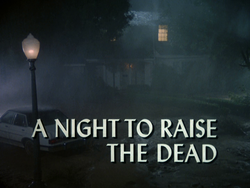A Night to Raise the Dead (Quincy, M.E.)
| A Night to Raise the Dead | ||||||||||||||||||||||||||||||||||||||
|---|---|---|---|---|---|---|---|---|---|---|---|---|---|---|---|---|---|---|---|---|---|---|---|---|---|---|---|---|---|---|---|---|---|---|---|---|---|---|

| ||||||||||||||||||||||||||||||||||||||
|
Episode Quote
"When rain tears open the earth and unearths secrets that were never meant to surface, someone has to stand guard between the dead and the living."
~ Dr. Quincy
Episode Overview
"A Night to Raise the Dead" is the ninth episode of season 3 of Quincy, M.E., originally aired on NBC on December 7, 1978 :contentReference[oaicite:1]{index=1}. A persistent rainstorm triggers a mudslide that unearths multiple bodies from a hillside cemetery, one of which is diagnosed with typhoid fever—turning a simple recovery mission into a public health crisis :contentReference[oaicite:2]{index=2}.
Table of Contents
Application of The QME Episode Laws
The QME Ep‑Laws manifest strongly in this episode:
✅ Law 1: Uncover truth & bring justice. While this episode emphasizes health over homicide, Quincy still fights to reveal the true cause and nature of the threat—typhoid—held in secrecy by cemetery officials and local authorities.
✅ Law 2: Explore social/ethical issues vs powerful systems. Here Quincy confronts institutional inertia and bureaucracy as cemetery management and public health officials resist his full investigation—prioritizing convenience over safety.
✅ Law 3: Tackle complex/controversial topics with respect. The specter of a typhoid epidemic—a serious real-world concern—is handled with scientific rigor and sensitivity, underlining Quincy’s urgent warnings and their ethical weight.
✅ **Law 4: Prioritize scientific accuracy. The episode hinges on forensic pathology—typhoid diagnosis via pathology, contaminated groundwater analysis, and proper corpse handling—showing accurate medical reasoning :contentReference[oaicite:3]{index=3}.
Episode Synopsis
A torrential rainstorm triggers a massive mudslide that buries and later uncovers a neglected hillside cemetery. As Quincy's team recovers several previously undocumented bodies, one corpse exhibits signs of typhoid fever. Quincy insists on testing all exhumed remains and local water supplies to trace the source of infection. The coroner’s office confronts pushback from cemetery officials and local politicians, who fear panic and liability. Quincy investigates flawed record-keeping, ignored burial regulations, and possible contaminated graves—exposing a public health emergency sealed by bureaucracy. He collaborates with Dr. Albers (Kevin Hagen) and epidemiologist Cliff Collier (Greg Morris) to trace infection pathways. Quincy’s persistence forces authorities to begin a full inspection of the cemetery and alert the public. The episode closes with Quincy ensuring proper decontamination protocols, preventing a looming epidemic.
Main Cast
- Jack Klugman as Dr. R. Quincy
- Robert Ito as Sam Fujiyama
- Val Bisoglio as Danny Tovo
- John S. Ragin as Dr. Robert Asten
- Garry Walberg as Lt. Frank Monahan
- Joseph Roman as Sgt. Brill
Guest Cast
- Greg Morris as Cliff Collier, epidemiologist
- Kevin Hagen as Dr. Dale Albers, public health official
- Jackie Joseph as Claudia Turner, cemetery records clerk
- (others listed in full credits) :contentReference[oaicite:4]{index=4}
Case File Summary
Victims: Multiple uncounted bodies; one bacteriologically tested positive for *Salmonella typhi*. Health Threat: Potential outbreak requiring urgent containment. Case Notes: Mudslide dislodged graves; improper burials and poor record-keeping impeded tracking; typhoid transmission through groundwater cited.
Forensic Science Insight
- Typhoid diagnosis via tissue culture and pathology.
- Investigation of environmental contamination—testing groundwater and proximity to graves.
- Forensic handling and cataloging of exhumed remains under legal standards.
Themes & Tropes
- **Public health vs bureaucracy** – battling cover-ups and official resistance.
- **Science as protector** – forensic pathology preventing illness.
- **Local negligence & collective responsibility** – institutional failure in cemetery management.
Reception & Ratings
The episode was well-received for spotlighting epidemiology and public health—uncommon focal points in 1970s crime dramas :contentReference[oaicite:5]{index=5}.
Trivia
- Greg Morris, known from Mission: Impossible, guest stars as an epidemiologist.
- Episode shined light on real-world cemetery regulation and burial health protocols.
- Typhoid reference reflects concerns of the era around waterborne diseases.
See Also
External Links
- [IMDb – A Night to Raise the Dead](https://www.imdb.com/title/tt0681744/)
- [TVMaze episode guide – S4E9](https://www.tvmaze.com/episodes/78292/quincy-me-4x09-a-night-to-raise-the-dead)
- [Trakt overview](https://trakt.tv/shows/quincy-m-e/seasons/4/episodes/9)
- contentReference[oaicite:6]{index=6}
